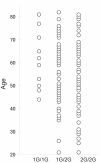The 2G allele of promoter region of matrix metalloproteinase-1 as an essential pre-condition for the early onset of oral squamous cell carcinoma
- PMID: 17919326
- PMCID: PMC2089080
- DOI: 10.1186/1471-2407-7-187
The 2G allele of promoter region of matrix metalloproteinase-1 as an essential pre-condition for the early onset of oral squamous cell carcinoma
Abstract
Background: Matrix metalloproteinase (MMP) is known to be involved in the initial and progressive stages of cancer development, and in the aggressive phenotypes of cancer. This study examines the association of single nucleotide polymorphisms in promoter regions of MMP-1 and MMP-3 with susceptibility to oral squamous cell carcinoma (OSCC).
Methods: We compared 170 Japanese OSCC cases and 164 healthy controls for genotypes of MMP-1 and MMP-3.
Results: The frequency of the MMP-1 2G allele was higher and that of the 1G homozygote was lower in the OSCC cases (p = 0.034). A multivariate logistic regression analysis revealed that subjects who were 45 years old or older had a significantly increased (2.47-fold) risk of OSCC (95%CI 1.47-4.14, p = 0.0006), and those carrying the MMP-1 2G allele had a 2.30-fold risk (95%CI 1.15-4.58, p = 0.018), indicating independent involvement of these factors in OSCC. One of the key discoveries of this research is the apparent reduction of the MMP-1 1G/1G and 1G/2G genotype distributions among the early onset OSCC cases under the ages of 45 years. It should be noted that the tongue was the primary site in 86.2% of these early onset cases. This could suggest the specific carcinogenic mechanisms, i.e. specific carcinogenic stimulations and/or genetic factors in the tongue.
Conclusion: Since the 2G allele is a majority of the MMP-1 genotype in the general population, it seems to act as a genetic pre-condition in OSCC development. However this report suggests a crucial impact of the MMP-1 2G allele in the early onset OSCC.
Figures
Similar articles
-
A Matrix Metalloproteinase-1 Polymorphism, MMP1-1607 (1G>2G), Is Associated with Increased Cancer Risk: A Meta-Analysis Including 21,327 Patients.Dis Markers. 2018 Dec 2;2018:7565834. doi: 10.1155/2018/7565834. eCollection 2018. Dis Markers. 2018. PMID: 30627228 Free PMC article. Review.
-
A single nucleotide polymorphism in the matrix metalloproteinase-1 promoter enhances oral squamous cell carcinoma susceptibility in a Chinese population.Oral Oncol. 2006 Jan;42(1):32-8. doi: 10.1016/j.oraloncology.2004.08.015. Epub 2005 Oct 25. Oral Oncol. 2006. PMID: 16256416
-
Correlation between functional genotypes in the matrix metalloproteinases-1 promoter and risk of oral squamous cell carcinomas.J Oral Pathol Med. 2004 Jul;33(6):323-6. doi: 10.1111/j.1600-0714.2004.00214.x. J Oral Pathol Med. 2004. PMID: 15200479
-
Association of matrix metalloproteinase-1 (-1607 1G/2G) polymorphism with increased risk for oral squamous cell carcinoma.Anticancer Res. 2007 Jan-Feb;27(1A):459-64. Anticancer Res. 2007. PMID: 17352267
-
Association between the MMP-1-1607 1G/2G Polymorphism and Osteoarthritis Risk: A Systematic Review and Meta-Analysis.Biomed Res Int. 2020 May 20;2020:5190587. doi: 10.1155/2020/5190587. eCollection 2020. Biomed Res Int. 2020. PMID: 32596320 Free PMC article.
Cited by
-
Revealing molecular mechanisms of early-onset tongue cancer by spatial transcriptomics.Sci Rep. 2024 Nov 1;14(1):26255. doi: 10.1038/s41598-024-76044-2. Sci Rep. 2024. PMID: 39482351 Free PMC article.
-
Single nucleotide polymorphisms in the matrix metalloproteinase gene family and the frequency and duration of gastroesophageal reflux disease influence the risk of esophageal adenocarcinoma.Int J Cancer. 2012 Dec 1;131(11):2478-86. doi: 10.1002/ijc.27541. Epub 2012 Apr 24. Int J Cancer. 2012. PMID: 22422400 Free PMC article.
-
A Matrix Metalloproteinase-1 Polymorphism, MMP1-1607 (1G>2G), Is Associated with Increased Cancer Risk: A Meta-Analysis Including 21,327 Patients.Dis Markers. 2018 Dec 2;2018:7565834. doi: 10.1155/2018/7565834. eCollection 2018. Dis Markers. 2018. PMID: 30627228 Free PMC article. Review.
-
Association of matrix metalloproteinase-3 -1171(5A>6A) polymorphism with cancer risk: a meta-analysis of 41 studies.PLoS One. 2014 Jan 29;9(1):e87562. doi: 10.1371/journal.pone.0087562. eCollection 2014. PLoS One. 2014. PMID: 24489939 Free PMC article.
-
Association between MMP1 -1607 1G>2G polymorphism and head and neck cancer risk: a meta-analysis.PLoS One. 2013;8(2):e56294. doi: 10.1371/journal.pone.0056294. Epub 2013 Feb 18. PLoS One. 2013. PMID: 23441173 Free PMC article.
References
-
- Impola U, Uitto VJ, Hietanen J, Hakkinen L, Zhang L, Larjava H, Isaka K, Saarialho-Kere U. Differential expression of matrilysin-1 (MMP-7), 92 kD gelatinase (MMP-9), and metalloelastase (MMP-12) in oral verrucous and squamous cell cancer. The Journal of pathology. 2004;202:14–22. doi: 10.1002/path.1479. - DOI - PubMed
-
- Brinckerhoff CE, Rutter JL, Benbow U. Interstitial collagenases as markers of tumor progression. Clin Cancer Res. 2000;6:4823–4830. - PubMed
-
- Nagata M, Fujita H, Ida H, Hoshina H, Inoue T, Seki Y, Ohnishi M, Ohyama T, Shingaki S, Kaji M, et al. Identification of potential biomarkers of lymph node metastasis in oral squamous cell carcinoma by cDNA microarray analysis. International journal of cancer. 2003;106:683–689. doi: 10.1002/ijc.11283. - DOI - PubMed
Publication types
MeSH terms
Substances
LinkOut - more resources
Full Text Sources
Medical
Miscellaneous


